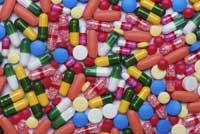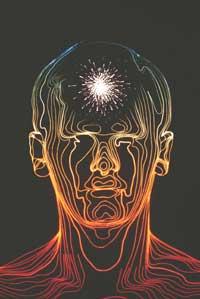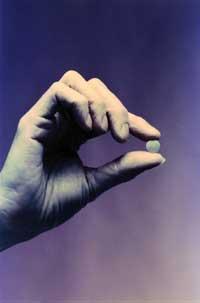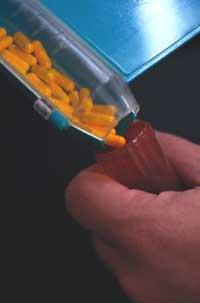Ecstasy, the greatest success in the drug world
2000/08/27 Kortabarria Olabarria, Beñardo - Elhuyar Zientzia

Ecstasy - MDMA or Methylenedioxymethamphetamine - is the most successful drug of the last decade. It is not the drug most used by people, but it has increased the most lately. In fact, in 1987, the relationship with heroin AIDS provoked a turning point in the world of drugs and the decline of heroin. The era of drugs of design and synthesis begins.

Tradition was new, but those drugs were not. These were existing substances that had gained some recognition in the market. Ecstasy, in its purest form, is a salty white powder. On the street, however, it is difficult to find it as it appears mixed with other substances: caffeine, ephedrine... And they are sold in pill or colored capsule form. MDMA was synthesized in 1912 by chemists from the German company Merck, who believed it could serve to eliminate hunger. Nor did it reach the market. In the 1950s, hoping it could be a good fight, the US army experimented with this drug. In the 1960s, it began to be used as a psychoactive drug in psychotherapy. In the 1980s it began to spread -associated with various cultural and musical movements. Acid house, rave, machine… are words of this environment.
Most of the ecstasy sold and received in Europe takes place in the Netherlands. In fact, there are easy tools to find, there are no problems to obtain basic chemicals and you can find chemicals prepared for it. The pathways for the synthesis of Ecstasy are several and it is not difficult to find new opportunities for chemists with some experience. In most European laboratories the system is based on the treatment of MDF-2P ketone. This product has been used until recently in industries, but now it is not so easy to acquire it. For that reason, underground producers have actually had to find other methods to obtain this ketone. Ecstasy is synthesized from this chemical. Later this ecstasy must become a pill or capsule.
Chemistry of Ecstasy

Ecstasy pills are very varied in shapes, colors, shapes and sizes; it is not possible to communicate a form. From outside they are different and from inside too. All that is sold in the name of ecstasy is not ecstasy. According to statistics, 80% of all pills and capsules sold on behalf of ecstasy would be 4 chemical binding amphetamines: MDMA, MDA, MDEA and MBDB. The first of them, the MDMA, the same ecstasy, is the one that most appears. Then comes the amphetaminic MDEA, a very similar drug. In the classification the MDA would be further, more toxic than the rest, and finally the amphetaminic MBDB. The rest of the pills sold on behalf of Estasi, 20%, have nothing to do with MDMA. They may contain amphetamine, caffeine, methamphetamines, antihistamines, antiallergic, antibiotics, etc. What is clear is that not knowing what the pills are, that the doses are completely different from one pill to another and that the use of toxic products for drug production can make ecstasy consumption a public health problem.
Despite the fake pills, in theory, the greatest risk of MDMA is in the neurochemical reactions that he himself causes in creating pleasure. When ecstasy reaches the blood, it targets neurons that release serotonin. As is known, serotonin regulates the mind. MDMA induces these cells to release serotonin to reach every corner of the brain. Artificially increasing serotonin levels can be dangerous. Normally serotonin level is maintained precisely, which is essential for the body, as serotonin controls appetite and body temperature. In fact, for the short, the greatest risk of MDMA is the sudden warming of hyperthermia or body. By filling the system with serotonin, after several doses for a single night, the body may lose the ability to control temperature. The situation itself doesn't help too much either, as most consumers are concentrated in crowded closed places, often dancing. As many newly-initiated do not know that water must be drunk, body temperature can rise above 43°C. At this temperature blood is strengthened and heart attacks are not rare.

Long-term risks also exist. George Ricaurte, a neurotoxicologist at Johns Hopkins University, believes that the number of serotonins is lost. In his work it is observed that the receptor of ecstasy costumbristas have less serotonin in the brain.
Exasperating
According to recent studies, about 65% of ecstasy users are men. Most of the population exposed to Asia (90%) is between 18 and 24 years old, although there are older and younger people. Most people who take ecstasy also take other drugs. Three out of four people are tobacco smokers. Others drink alcohol. A few burn haxis regularly. One in four includes amphetamine and methamphetamines -speed-, but not opiates.
Given the frequency or need for consumption of Ecstasy, according to a study conducted in Spain, five types of ecstasy consumers are distinguished:
- Experimental: People who consume less than 10 times a year, 23.7%.
- Sporadic: Between 10 and 50 times a year, 33.3%.
- Common: Between 50 and 100 times a year, 25%.
- Intensive: Between 100 and 400 times a year, 15%.
- Living: 3% of those who consume more than 400 times a year.
According to this research, ecstasy addicts mention many reasons for taking drugs and most claim that it is a controllable drug that cannot produce addiction. They say it is also a clean, easy to use, comfortable and cheap drug compared to others.
Among the experts there is a fairly broad debate about the effects that this drug and other similar produce on the body. MDMA produces in the human body more than 75-100 mg, approximately half an hour of its administration, while the effect disappears at 4-6 hours. According to scientists, ecstasy or MDMA has two basic types of effects: stimulant and psychedelic. According to the receptors, the effects can be classified into five groups:
- Changes in mood: joy, energy, happiness, shame, laughter, more sensuality, more spirituality, resurrection of self-esteem and more aggressiveness.
- Ease of contact and conversation.
- Changes in perception and hallucinations.
- More sexual passion.
- Clarity of ideas and greater capacity for concentration.

Apparently, in general, it can be said that ecstasy is stimulating, increases sexual desire and facilitates human relationships. However, ecstasy also has very different effects: thirst, dry mouth, heat, insomnia, excessive sweating, tachycardia, uncontrollable movements, anguish…, which disappear a few hours after taking the drug. But ecstasy also has lasting effects: tiredness, concentration difficulties, lack of hunger, memory loss, loss of ability to work, anger, depression and lack of sexual desire. Therefore, there is a huge contrast between the energy that occurs shortly after ecstasy and the feeling of happiness and slowness -24 hours.
"Most people who have taken MDMA," says neurotoxicologist Ricaurte, "seem normal, but within 10-20 years we may see that the drug was not as good as we could imagine."
Published in 7

Gai honi buruzko eduki gehiago
Elhuyarrek garatutako teknologia






